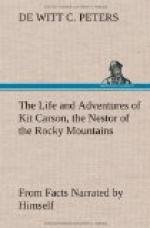[Footnote 25: Company D, 2d Regiment U.S. Artillery.]
There being nothing more that could be accomplished by the pursuit, consequently, Col. Cook ordered his men to face about, and they having done so, he made a direct march to Abiquiu, a Mexican village that is located on the Rio Chamo, a tributary of the Rio del Norte. The design he had in going there was to recruit his men and animals. Their sufferings had been severe. Although performing constantly more than double duty, the entire command was put upon half allowance of food, and that little could not be properly cooked. For this reason, the trials and hardships which they experienced were of no ordinary character.
The town of Abiquiu, where Colonel Cook arrived, is about sixty miles northwest from Santa Fe, and a traveler can make a journey through valleys from one town to the other. It stands next to Taos in point of magnitude and importance in the matter of townships in the north of New Mexico. The scenery about this settlement is very attractive, and, as it lies on the borders of the Utah Indian country, it is frequently visited by these Indians. The neighbors of the Utahs, the Navajoes, occasionally make their appearance in the town. The Mexicans of Abiquiu, from their continued intercourse with bands of the Utah Indians, are more or less linked in with them; and, in time of war, the Americans can place but little confidence in the inhabitants of Abiquiu on this account. The grazing and farming facilities of the country adjacent to this town are quite progressive, and were it not for the Indians, its resources would be much more rapidly developed than they now are.
Utah was originally part of the territory of Upper California. The United States came into possession of it by treaty with Mexico in 1848. The population is chiefly Mormon. The new territory, as set off by the United States in 1850, includes an area of one hundred and eighty-seven thousand, nine hundred and twenty-three square miles, or one hundred and twenty millions, two hundred and seventy thousand and seven hundred and twenty acres. Near the eastern base of the Sierra Nevada range there are several lakes which receive the waters of the eastern slope of these leviathan mountains. One of these lakes bears the name of Kit Carson, having been named Carson Lake by Colonel Fremont.




